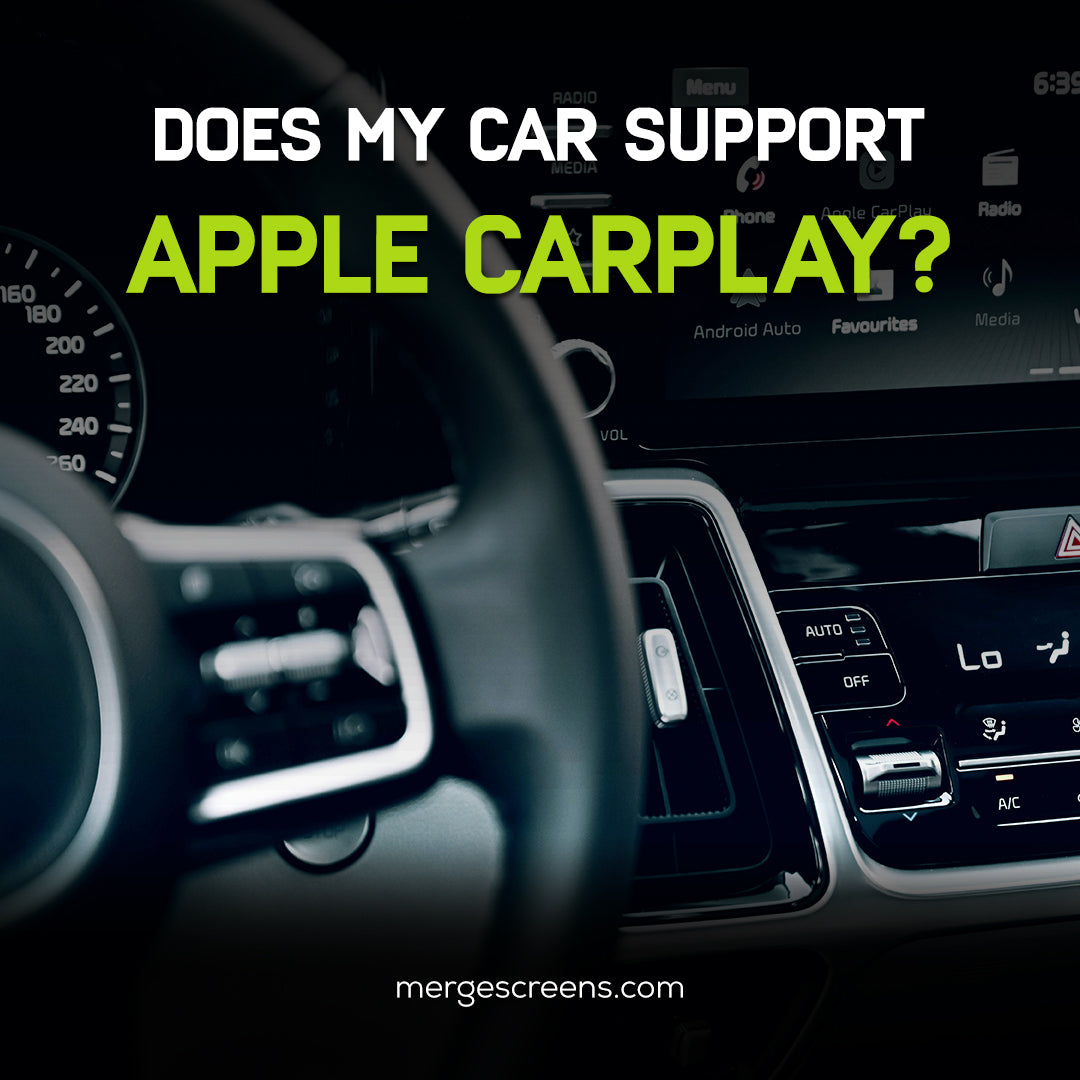Does My Car Support Apple CarPlay?

In today’s always-connected world, drivers want more than just a radio and Bluetooth. They want real-time navigation, hands-free texting, Spotify playlists, and even podcasts—all safely integrated with their vehicle. That’s where Apple CarPlay comes in.
But before diving into installation, one question pops up time and time again: “Does my car support Apple CarPlay?”
In this guide, we’ll walk you through everything you need to know—from checking compatibility to installation, understanding key features, and where to turn for model-specific help.
Why Drivers Are Upgrading to Apple CarPlay
Let's be honest: OEM infotainment systems don't always work well. Clunky interfaces, outdated maps, and limited app support make for a frustrating experience. Apple CarPlay solves that by transforming your car’s dashboard into a familiar iOS-powered screen.
Whether you're navigating to a new city, replying to texts with Siri, or choosing the perfect playlist, CarPlay keeps you connected without pulling focus from the road.
Step 1: Is Your Car Compatible With Apple CarPlay?
Before anything else, you need to know whether your vehicle supports Apple CarPlay out of the box—or if it needs a little help.
Factory CarPlay Support
You can get Apple CarPlay in more than 800 automobile models from well-known automakers like:
● Ford
● Toyota
● Honda
● Chevrolet
● BMW
● Kia
● Hyundai
If you’re driving a model year 2016 or newer, chances are good that it’s either CarPlay-ready or can be upgraded with a firmware update. Check your automaker’s website or owner’s manual to confirm.
Aftermarket Compatibility
If your car is older or didn’t come with CarPlay, don’t worry. Many vehicles can still be upgraded using an aftermarket CarPlay module or screen upgrade. These are especially popular for trucks and SUVs that owners plan to keep long-term.
Want a head start? MergeScreens offers plug-and-play Apple CarPlay upgrade kits for a wide range of vehicles, including model-specific units for Ford, Lexus, and more.
Step 2: How to get Apple CarPlay to work in your car
So you’ve confirmed compatibility. What now? You’ve got two main options: DIY installation or professional help. Here's a quick breakdown.
Tools You Might Need (for DIY Installations)
● Trim removal tool kit (plastic pry bars)
● Screwdriver set
● Wiring harness adapter (usually included with kits)
● Electrical tape or zip ties (for cable management)
● Microfiber cloth (you’re working around your dash, after all)
Basic Installation Steps
1. Disconnect the battery.
Safety first—always start here.
2. Remove the dashboard trim.
Use trim tools to avoid damaging plastics.
3. Take out the old head unit.
Unscrew and carefully disconnect existing wiring.
4. Plug in the CarPlay system.
You can attach the power cord, speakers, and input/output cables using the harness.
5. Secure the new unit.
Put the new screen or module on and put the trim back on.
6. Reconnect the battery and test.
Make sure everything powers on and functions properly.
Not all systems are created equal—some vehicles may require coding or additional components. When in doubt, check out the our MergeScreens installation guide for step-by-step help and visuals.
When to Call a Pro
If you're not comfortable removing your dashboard or working with vehicle wiring, consider hiring a local auto electronics shop. Many offer CarPlay installations starting around $100–$300, depending on vehicle complexity.
Step 3: What Features Does Apple CarPlay Actually Offer?
Apple CarPlay isn't just about mirroring your iPhone—it’s about enhancing your driving experience safely and smartly.
Voice Control with Siri
● Ask for directions
● Send and read messages
● Make calls
● Control music—all hands-free
This is a game-changer for being productive while still paying attention to the road.
Turn-by-Turn Navigation
CarPlay supports:
● Apple Maps (default)
● Waze
You can get real-time traffic reports, alternative routes, and voice-guided directions on all of them.
App Integration That Works
Popular apps that run flawlessly on CarPlay include:
● Spotify, Apple Music, Pandora (for audio)
● Messages, WhatsApp, Telegram (for communication)
● Calendar, Reminders, and even Podcasts
They add new apps all the time, and all of them work well with voice control and big screens.
Step 4: Where to Find Vehicle-Specific Information
Even if your vehicle seems compatible, some model-specific quirks can affect installation or usage. Here's where to look for help:
1. Your Owner’s Manual
This is still the best place to start. Look under sections like Infotainment, Audio Settings, or Connectivity.
2. Vehicle Forums
Enthusiast forums like:
● RAV4World
● F150Forum
● BMW Bimmerfest
Usually have thorough instructions, troubleshooting suggestions, and do-it-yourself advice that is specific to your make and model.
3. MergeScreens Product Pages
When looking for an update, make sure you read the product page and FAQs thoroughly. MergeScreens, for instance, clearly lists:
● Supported model years
● Installation difficulty level
● In-box components
● Customer reviews (helpful for real-world expectations)
Pro Tips Before You Start the Upgrade
✓ Backup your settings
If your vehicle has stored preferences, save them before disconnecting anything.
✓ Check for firmware updates
Some newer vehicles may require a dealer-installed update to unlock CarPlay.
✓ Use quality parts
Stick to trusted brands and verified sellers—especially when it comes to wiring harnesses.
Ready to Enjoy Apple CarPlay?
Whether you're commuting to work, road-tripping on weekends, or just trying to keep your eyes on the road while staying connected, Apple CarPlay can completely transform your in-car experience.
Take the time to check your vehicle’s compatibility, weigh your install options, and explore all the features waiting at your fingertips. At first, upgrading could seem scary, but the end result? Seamless tech that feels like it was always meant to be there.
You can also explore these Apple CarPlay and Android Auto modules available for a wide range of vehicle models on MergeScreens.
FAQs: Compatibility & Installing Apple CarPlay
1. How do I know if my car supports CarPlay?
Check your manual, automaker’s site, or Apple’s official list. Older cars may require aftermarket kits.
2. Can I add CarPlay to a 2010–2015 vehicle?
Yes, many aftermarket kits work with older cars using plug-and-play displays.
3. How do I find local CarPlay installers?
You can do a search (on a search engine like Google) using these keywords "Apple CarPlay installer near me" or "CarPlay upgrade [your city or ZIP]"
4. What’s the cost to install CarPlay?
$300–$900 depending on car, kit type, and installation method.
5. Is professional installation better?
Yes, especially if you want to retain steering wheel controls or avoid dashboard disassembly.
6. What cars are easiest to upgrade?
Vehicles with double-DIN head units like Toyota, Ford, Honda, or Chevrolet.
7. What features does CarPlay include?
Siri voice control, maps, messaging, music apps, hands-free calling.
8. Can I use wireless CarPlay?
Yes, many modern kits include wireless support.
9. Will my steering wheel controls still work?
Most quality kits retain factory controls—especially when installed professionally.
10. Where can I find a DIY CarPlay guide?
Here’s a full guide: How to Install Apple CarPlay in Your Vehicle
11. Are there model-specific CarPlay kits?
Yes—MergeScreens offers kits for popular models like the Ford F-150, Lexus RX, and Toyota Tacoma.
12. Where is my car’s manual?
It’s in the glovebox or downloadable from your carmaker’s support site.
13. Will this void my car’s warranty?
No, under the Magnuson-Moss Warranty Act, aftermarket parts don’t void warranties unless proven to cause damage.
14. What are the best apps for CarPlay?
Apple Maps, Google Maps, Waze, Spotify, WhatsApp, Apple Music, and Audible.
15. How long does installation take?
Pros: 1–3 hours
DIY: 2–4 hours depending on experience

